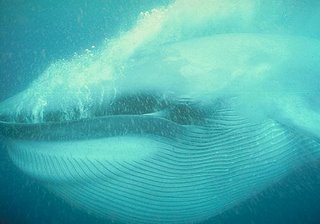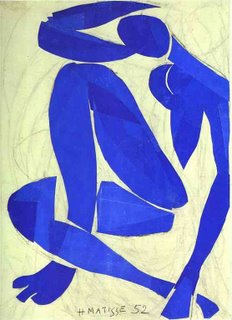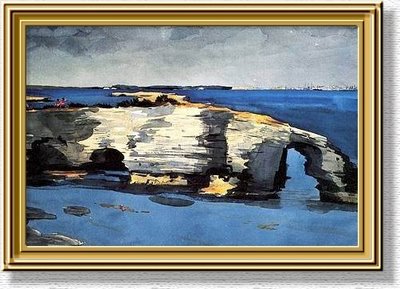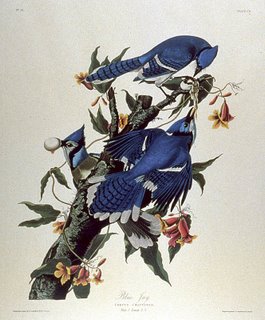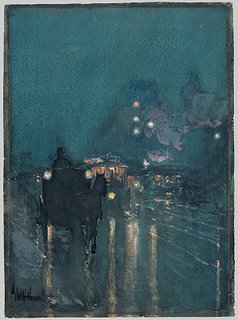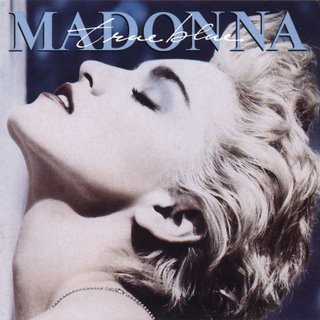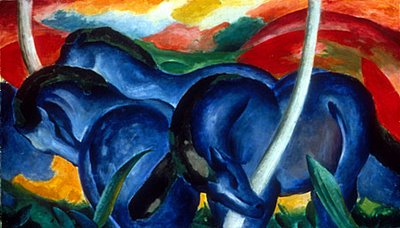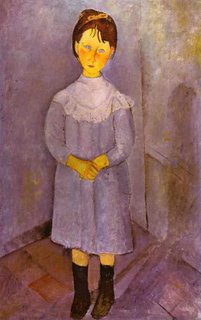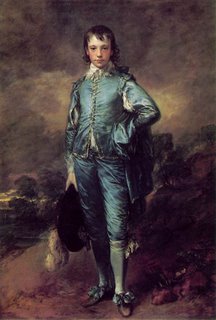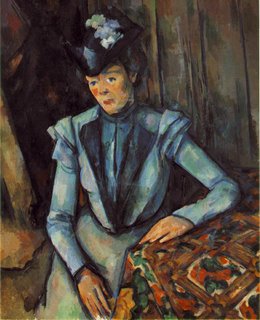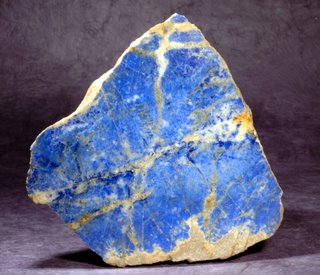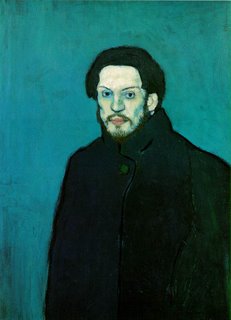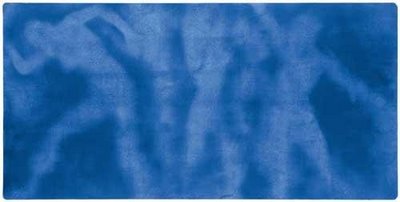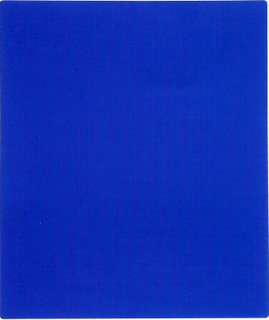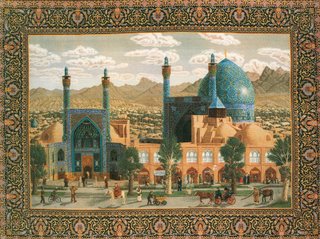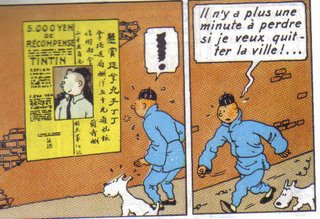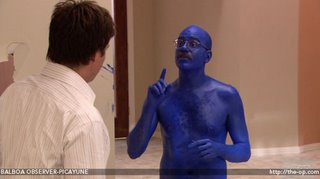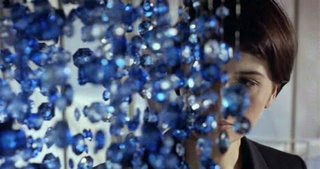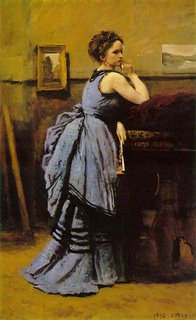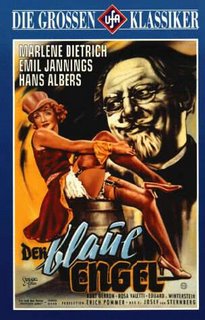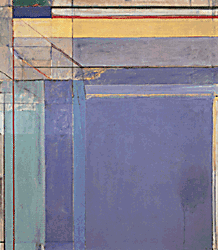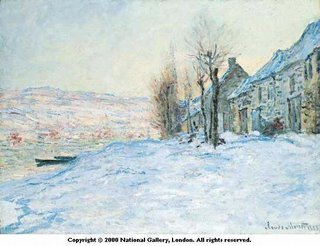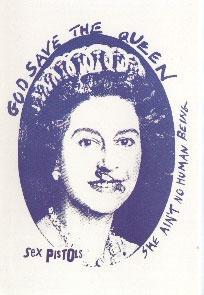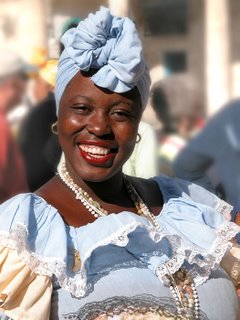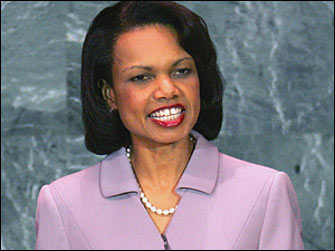
Larry Clinton, Deep Purple.
Art Tatum, Deep Purple.
The Clientele, The Violet Hour.
Sebadoh, Violet Execution.
The Kooks, Indigo Lights.
Pyotr Tchaikovsky, Dance of the Lilac Fairy.
Prince, Purple Rain.
Stina Nordenstam, Purple Rain.
Jimi Hendrix, Purple Haze.
Scott Joplin, Heliotrope Bouquet.
Eva Taylor, Jeannine I Dream of Lilac Time.
Jeff Buckley, Lilac Wine (live).
The Kinks, Lavender Hill.
The Real Tuesday Weld, On Lavender Hill.
Duke Ellington, Lady in the Lavender Mist.
Scrugg, Lavender Popcorn.
Dexter Gordon, The Girl With the Purple Eyes.
They Might Be Giants, Purple Toupee.
Duke Ellington, Mood Indigo.
Frank Sinatra, Mood Indigo.
Nina Simone, Mood Indigo.
Duke Ellington, Mood Indigo.
Perhaps, if winter could penetrate
Through all its purples to the final slate...
Wallace Stevens, The Man Whose Pharynx Was Bad.
Purple is the color of waning--of old age ("When I am an old woman/I shall wear purple", begins Jenny Joseph's Warning), dusk ("when purple-colored curtains mark the end of the day," the Platters' "Twilight Time"), finality, evensong, the East, grace, solemnity, death ("none can avoid this purple," Emily Dickinson said of the last).
It is the weakest color--the color with the shortest visible wavelength--yet it is traditionally worn by the mightiest: archangels, Roman emperors, Church cardinals, Greek gods. "Purple is the magisterium," wrote Alexander Theroux. "O purple Sovereignty, Holiness, Reverence," says Carlyle in The French Revolution. And mountains, the earth's most ambitious works, are often depicted as purple, in "America the Beautiful" and by Dickinson:
The Mountains--grow unnoticed--
Their Purple figures rise
Without attempt--Exhaustion--
Assistance--or Applause--
Purple is a cold color, steeped in mystery; it is always at one remove from us. Its parentage is of the highest royalty--mysterious, regal blue, and titanic red--yet it is not entirely linked with the ruling class, as it is a color long embraced by eccentrics and the avant garde, by Oscar Wilde and Prince. It is a color of rituals: the Incas would perform an annual dance in long purple robes, "called Capac Raymi, a ceremony of the royal or great lords," wrote Pedro Sarmiento De Gamboa.
It is sometime associated with braggarts and egoists (both Shelley and Shakespeare refer to "purple pride"), and with stubbornness and resistance (the maid Nelly Dean in Wuthering Heights shows a "decided purple witness" and stands up to her mistress Catherine, for which Nelly earns a slap in the face).
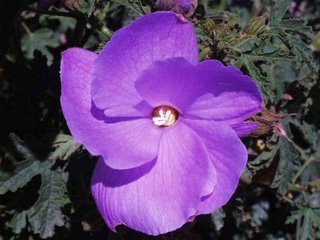
In music, purple has a rarefied presence, although Scriabin found both the keys of D-flat and A-flat to be purple. A few select instruments are said to be purple in tone--Kandinsky heard purple in the English horn, Goethe in the French horn, Theroux in the tympani, such as the one at the beginning of Beethoven's Violin Concerto. Some woodwinds, especially the oboe and bassoon, seem purple to me. And purple songs, for whatever reason, are often sung quietly, with breathy, barely-there vocals (see, in this list, Stina Nordenstam, The Clientele, The Real Tuesday Weld, etc.)
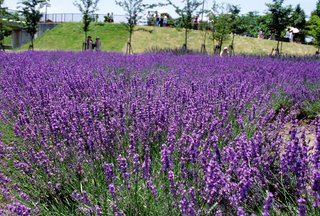
I think it pisses God off if you walk by the color purple in a field somewhere and don't notice it.
Alice Walker, The Color Purple.
The ultimate purple song is, naturally, Peter DeRose's "Deep Purple," a solemn, slightly ponderous number, first performed by Paul Whiteman and which, after receiving a set of lyrics from Mitchell Parish, became a huge hit for Larry Clinton in 1938. Of all of Clinton's "color" songs (most of which have been featured in this series), this was the most enduring, a reverie for a world about to convulse into bloody war.
Clinton's version, with vocals by Bea Wain, can be found on Studies in Clinton.
And the following year the master Art Tatum took the song and performed his usual prestidigitation. Tatum’s version of “Deep Purple” is quite minimal by Tatum’s standards—-no wild runs down the keyboard, little ornamentation, no constant harmonic movement. Rather, it’s a fairly linear performance, with Tatum’s left hand providing the rhythm and developing chords, while his right hand dances out with the melody. It’s a precursor to the sort of clean, modern style practiced in the ‘40s by Nat King Cole and Billy Kyle. Find on I Got Rhythm Vol. 3, used here or via download here.
The formless color
And o'er the sameness of the purple sky
Heaven paints, with hurried hand, wild hues of every dye.
John Clare, November.
What exactly do we mean when we say "purple", anyway? No other color goes by so many different names (mauve, heliotrope, lavender, puce, etc.) nor has so many different identities. Sometimes purple disappears entirely, as there are the two colors which take its place in the "ROYGBIV" mnemonic: indigo and violet.

The sad fate of Violet Beauregarde
So who rules the realm? Indigo is, according to my stalwart resource, the unabridged Webster's New Twentieth Century Dictionary, a "deep violet-blue" and violet is, in turn, "a bluish purple color". So this creates a solid line of succession--indigo is a blend of violet, violet is a blend of purple, and thus violet and indigo are vassals to purple. But Isaac Newton elevated indigo and violet beyond their station when he placed them in his list of the seven primary colors, and so generations of schoolkids have learned to accept them as usurpers.
I Tiresias, though blind, throbbing between two lives,
Old man with wrinkled female breasts, can see
At the violet hour, the evening hour that strives
Homeward, and brings the sailor home from sea...
Eliot, The Waste Land.
The Clientele's "The Violet Hour," a track whose sound could serve as a musical definition of crepuscular, is from their 2003 record of the same name. Clientele tour dates; Myspace page.
"Violet Execution" is off Sebadoh III, from 1991. A record that was required listening, whether you liked it or not (see also, Loveless, Slanted & Enchanted), if you were in an arty college during those years.
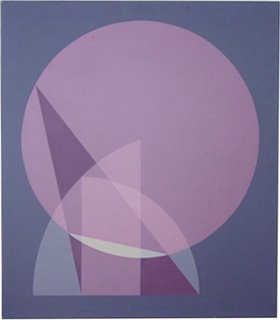
Crockett Johnson, A Construction for the Heptagon (Neusis II), c. 1970.
And "Indigo Lights" was the leadoff track on a 1999 record called Too Much Is Not Enough by The Kooks, a Swedish band from whom little has been heard since their last record in 2002. Just to confuse things, there is a new UK band of the same name which has just released its debut CD and will be touring the US this fall. So likely tons of kids on the Hype Machine will stumble into this site in fruitless search of them.
Purple fantasias
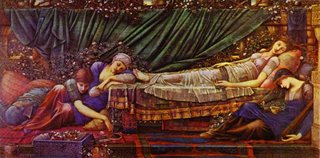
Edward Burne-Jones, The Sleeping Beauty, c. 1880.
Down yonder glade two lovers steal, to shun the fairy-queen,
Who frowns upon their plighted vows, and jealous is of me,
To seek the purple flow'r, whose juice from all her spells can free
Ann Radcliffe, The Mysteries of Udolpho.
Purple is often the color of dreamscapes, fantasies, netherworlds. You may remember that The Sleeping Beauty begins with a host of fairies attending the wedding of Princess Aurora, each bestowing gifts of grace and loveliness, until the evil fairy Carabosse appears. Infuriated that she had been snubbed from the wedding, Carabosse places a curse on Aurora--that she will prick her finger and die. But luckily, the Lilac Fairy had yet to bestow her gift. Unable to reverse the curse, the Fairy instead alters it, so that when the princess pricks her finger, she will instead sleep for 100 years.
The gorgeous "Dance of the Lilac Fairy" is from the orchestral suite of Pyotr Tchaikovsky's ballet of the Sleeping Beauty (op. 66), which premiered in 1890. Find here.

"Purple Rain": I remember an article in which Prince's bodyguard, "Big Chick" Huntsberry, was shooting the breeze during the Purple Rain sessions, and was in awe of attending the taping of the title track. "It was like Willie Nelson last night," he recalled. One of Prince's most iconic tracks, ending with one of his finest guitar solos on record. On 1984's Purple Rain.
And Stina Nordenstam's grave assai cover version is on 1998's People are Strange.
Tomorrow or just the end of time?

"I dream a lot and I put a lot of my dreams down as songs," Jimi Hendrix once said. "I wrote one called The Purple Haze which was all about a dream I had that I was walking under the sea." Hendrix, a huge science fiction fan, also remembered a story he had recently read in Fantasy and Science Fiction, an excerpt from Philip José Farmer's Night of Light, which contains the line "the sky was clear but the stars seemed far away, blobs straining to pierce the purplish haze."
Chas Chandler recalled that Hendrix began writing the song on the afternoon of Boxing Day, 1966, killing time at the Upper Cut Club. "He started playing the riff, and I said 'write the rest of that!', so he did." At one point, "Purple Haze" had a dozen or more verses, which included a vast SF mythology, like "the history of the wars on Neptune," Hendrix said.
The amazing fuzz-toned guitar sound was achieved when Hendrix was approached by Roger Mayer, an inventor who worked for the Royal Navy Scientific Service. Mayer showed up at the "Purple Haze" sessions with a fuzz box he had designed called the Octavia, which Hendrix used to overdub his solo. The Octavia, Mayer said later, was designed to create an "infinite mirror image" of a guitar's sound. And when "Purple Haze" was released in March 1967, it would vault Hendrix into the stratosphere. Find on Are You Experienced.
Lilac Time
What is the essence of purple? Some works of art seem especially associated with the color. Virginia Woolf's The Waves, for instance, the most staggeringly beautiful book Woolf ever wrote, is a purple empire, filled with lines like:
This is our world, lit with crescents and stars of light; and great petals half-transparent block the openings like purple windows.
and,
Or perhaps they saw the splendour of the flowers making a light of flowing purple over the beds, through which dark tunnels of purple shade were driven between the stalks.
and again,
I shall be sullen, storm-tinted and all one purple. I shall be debased and hide-bound by the bestial and beautiful passion of maternity. I shall push the fortunes of my children unscrupulously. I shall hate those who see their faults.

Some purpuraceous music:
Scott Joplin's "Heliotrope Bouquet", a "slow drag two-step for piano" from 1907, is a collaboration with Louis Chauvin, who wrote the first two of the piece's four sections (the "A" section's complex tango rhythms and intricate melodies are fairly unusual for ragtime)--they are the only pieces of music to survive from Chauvin, a talented pianist who lived chaotically and died at 24 of syphilis and multiple sclerosis. Find on Elite Syncopations.
"Jeannine I Dream of Lilac Time" is on the out-of-print Eva Taylor Vol. 3 (and on iTunes). Eva Taylor is perhaps best-known for being married to the bandleader Clarence Williams, but she had a fine, if not incredibly memorable voice, and could have had a career as a sort of minor Ethel Waters. But after 1932, she stopped recording. Among her better tracks is "Jeannine," which she recorded under her real name Irene Gibbons, with the great guitarist Eddie Lang. King Oliver is on trumpet, Williams on piano.

"Lilac Wine," first put on the map by Nina Simone, was a constant source of intrigue for Jeff Buckley. About a year before drowning in the Mississippi River, Buckley performed this version on stage in Melbourne. On Mystery White Boy.
The rarest

Porphyry head, 4th C.
Raise me a dais of silk and down;
Hang it with vair and purple dyes;
Carve it in doves and pomegranates,
And peacocks with a hundred eyes.
Christina Georgina Rossetti, A Birthday.
Purple was once the most precious color of all.
It begins, like many things, with the Phoenicians, seafarers and dyers, who discovered that a vibrant dye could be extracted from two types of Mediterranean shellfish, buccinum and purpura. In both mollusks, the color is found near the head, in a gland that came to be known as the "flower." Either you squeezed the mollusks in a press or you cracked them open by hand--in either case, it was a laborious process. Once the fluid was removed, it turned from white to purple in the sunlight.
The problem was that the shellfish had literally a drop of the stuff in them apiece. It is estimated it took 250,000 shellfish to produce one ounce of purple dye. Thus it was astonishingly expensive. A well-paid Roman baker, for example, would have to spend three year's salary to afford a pound of purple-dyed wool. Tyrian purple, as it became to be called (after the Phoenician city of Tyre), was soon coveted by the rising power in the Mediterranean--the Romans.
[Purple], that precious color which gleams with the hue of a dark rose...This is the purple for which the fasces and axes clear a way. It is the badge of notable youth; it distinguishes the senator from the knight; it is called in to appease the gods. It brightens every garment and shares with gold the glory of the triumph.
Pliny, Natural History, IX, XXXVI.
At first, most leading members of the Roman Republic could wear purple--generals would wear purple cloaks on the field, senators were allowed to wear togas with purple bands on the hems. But as the Republic began to founder, the ambitious men who came to rule it found that purple best suited them alone...
There Lythe a Knygt

The Tetrarchs, St Mark's Basilica, Venice, c. 300 AD.
Purple is the traditional mantle of power, worn, for example, by the Archangel Michael, as described in Paradise Lost:
Over his lucid arms
A military vest of purple flowed,
Livelier than Meliboean, or the grain
Of Sarra, worn by kings and heroes old
In time of truce; Iris had dipt the woof.
Such an association likely began with Julius Caesar, the first Roman emperor. (Caesar got the idea to don the purple from his lover Cleopatra, who was a master at using purple as a visual shorthand for power.) When he was stabbed to death in the Senate, Caesar drew his purple toga over his face as he died. And after winning the subsequent battle for power, Marc Antony came upon the body of Brutus, Caesar's most notable assassin, which he covered with a purple robe.
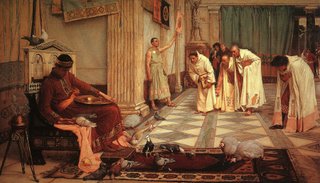
By the time of Ammianus Marcellinus, the chronicler of the waning days of the Empire, aspiring emperors were as common as seed corn, and all would-be tyrants grabbed the purple as the first act of their insurrection. It became a crime under Valentinian I for anyone but the emperor to wear purple, and Ammianus is full of sad stories of men being executed for stumbling and grabbing a purple tapestry, for example.

There was a sort of purple dark ages: in the 7th Century, Tyre was overrun by the Arabs and the great purple dye works destroyed. Around the same time, the secret of tekhelet, the Hebrew method of deriving an indigo dye from rock snails, was lost. And when Constantinople fell in 1453, the method of making purple was lost, apparently forever.
All that remained was the memory of imperial, Tyrian purple--a color of power at a scale that, during the Middle Ages, seemed inconceivable. It was natural that purple became a favored color for Christian works, such as the utterly haunting 15th Century hymn The Knight of the Grail, also known as the Corpus Christi Carol:
He bare hym up, he bare hym down,
He bare hym into an orchard brown
In that orchard ther was an hall
That was hangid with purpill and pall.

Purple Democracy
Suddenly, around 1850, the Western world rediscovered purple. A Frenchman named Felix Henri de Lacaze-Duthiers noticed a Mediterranean fisherman wipe his shirt with a mollusk, leaving a stain that the sun dried into a vivid purple. There was a growing mania to discover the source of classical purple--Napoleon III soon sent out an archaelogical expedition to uncover the location of ancient Tyre, and, hopefully, unearth the secret of purple dyeing as well. (Of course, all Napoleon III had to do was send someone to Central America, where dyers had been making purple from shellfish for centuries...)
Yet such efforts proved pointless, as at the same time the secret of mass-producing purple was discovered. In 1856, William Henry Perkin, an 18-year-old chemistry student, took over the top floor of his parents' home in the East End of London as a laboratory. He was looking to find an alternative to quinine, the malarial remedy, and was experimenting with adding hydrogen and oxygen to coal tar. One night, as he was about to throw out another failed solution, he noticed it had "a strangely beautiful color," as he told a journalist years later. (from Victoria Finlay's Color).
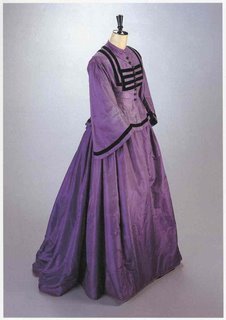
mauve-dyed dress, c. 1862
Perkin first called his discovery "Tyrian Purple", perhaps recalling the Latin histories he had learned in school, but soon changed his mind. The color, he decided, would be named after a French flower: mauve. (The French, naturally, would call the hue "Perkin's Purple".) Perkin opened a dye factory to produce the color, which was soon embraced by textile makers. By his 21st birthday, Perkin was rich and the stage was set for what would be called "The Mauve Decade", a rather fluid period (and not really a decade) which encompassed roughly 1860 to 1900, during which the color became the height of fashion.

Arthur Hughes, April Love, 1856.
The Impressionists, for one, went mad for synthetic mauve, indigo and violet. Monet, in particular, indulged in what some wags called "violettomania." "I have finally discovered the true color of the atmosphere," Monet said. "It's violet. Fresh air is violet. Three years from now everyone will work in violet."

And no color has fallen so much in esteem since the advent of synthetic dyes and paints. Purple's status as an aristocratic color began to wane as soon as it could be mass-marketed.
By 1877, Charles de Coster, "a militant Fleming, a revolutionary and a Freemason", as described by Herman Pleij, went on a tour of the Low Countries and was astonished at the colors he encountered. In Amsterdam, de Coster noted that lilac appeared to be the favorite color of Dutch domestic servants, and that dozens of purple variations appeared in the bargain shops. It was the end--democratization had seized purple and cast it downward, to today, when, as Pleij writes:
"A sign of the times...[is] the sight of whole families strolling around holiday resorts and shopping malls in jogging suits of glowing purple. This was the very color that signaled distinction in the Middle Ages and was the rightful property of the aristocracy."

A host of eccentrics
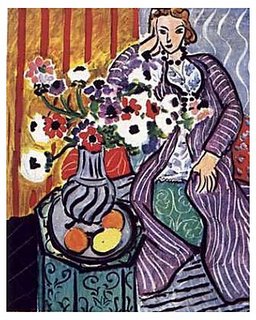
Matisse, Purple Robe and Anemones, 1937.
Yet despite purple's decline in status among the upper class, its relations with the eccentric, the mad, the extravagant and ridiculous remains as strong as ever.
Ronald Firbank wrote in purple ink. Des Esseintes, the aesthete in Huysmans' A Rebours, adorns his shirt with Parma violets, as did Proust's Odette, and Dorian Gray, whose portrait is shrouded in a purple-gold coverlet. One of Sherlock Holmes' dressing gowns is purple. Joyce's Mr Bloom wears purple elastic stock suspenders. And Mary, a character in Aldous Huxley's Crome Yellow, wears " purple pyjamas [that] clothed her with an ampleness that hid the lines of her body; she looked like some large, comfortable, unjointed toy, a sort of Teddy-bear."
And Keith Moon owned the only purple Rolls Royce ever made, though, according to Wikipedia, "this was disputed by Rolls Royce, who claimed Moon had it repainted. The car is now owned by Middlebrook Garages, Middlebrook Lane, Bagthorpe, Nottinghamshire, England."

Oscar Wilde in particular seems insperable from purple. Copies of his play Salome (in which he insisted all actors playing Romans should wear purple) were bound in purple. In Wilde's final letters, he seems consumed with the color--in a 1900 letter to Robert Ross, Wilde writes, "And yet what purple hours one can snatch from that grey slowly-moving thing we call time." And during his time in prison, Wilde fantasized about his day of release: "On the day of my leaving both the laburnum and the lilac will be blooming in the gardens. I shall see the wind...make [the lilac] toss the pale purple of its plumes, so that all the air shall be Arabia for me."
The Kinks' "Lavender Hill" was recorded in 1967, an outtake from the Something Else sessions. It was officially released on a 1973 LP called The Great Lost Kinks Album, which lived up to its name by never getting released on CD. "Lavender Hill" did turn up on CD at last, buried on the third disc of a mega-re-release CD of Village Green Preservation Society, which is likely to go out of print soon, given this song's unlucky history.
"On Lavender Hill" is by The Real Tuesday Weld. First heard this one on Moistworks last year. On 2005's The Return of the Clerkenwell Kid.

Picasso, The Absinthe Drinker, 1901.
“Lady of the Lavender Mist," one of the many purple Ellington compositions, was recorded in August 1947, during Ellington’s first session for Columbia. Lawrence Brown provides the trombone solo. On Masterpieces.
Scrugg's "Lavender Popcorn," a nice bit of bubblegum psychedelia, was one of the band's three singles, released by Pye in 1968. Scrugg was led by the South African guitarist/songwriter John Kongos, who went on to have some solo hits in the UK. Find here.
Purple decadence
But what an attenuation was this cold pride of the dream of her youth, in which she had pictured herself walking in state towards the altar, flushed by the purple light and bloom of her own passion..
Thomas Hardy, The Woodlanders.
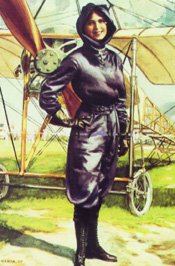
Purple also has its sensual side. Harriet Quimby (above), bombshell and flying ace (she was the first woman to fly over the English Channel) always wore a shining purple satin flying costume. The rake Robert Lovelace, fantasizing about his potential conquest of Clarissa Harlowe in Richardson's Clarissa, imagines she will kiss him with a "purple mouth" ("Her coral lips will be purple then, Jack!"). And then there is the mysterious woman described in Swinburne's Laus Veneris, who seems to have met a vampire:
Asleep or waking is it? for her neck,
Kissed over close, wears yet a purple speck
Wherein the pained blood falters and goes out;
Soft, and stung softly--fairer for a fleck.
There are those with purple eyes, as as Claggart in Melville's Billy Budd, who has "orbs which in repose were of a color nearest approaching a deeper violet, the softest of shades." Elizabeth Taylor, according to legend, had violet eyes (Doonesbury, spoofing her sixth husband John Warner's senatorial campaign, had Warner offering bumper stickers with the slogan "A Tad Overweight, But Violet Eyes to Die For").
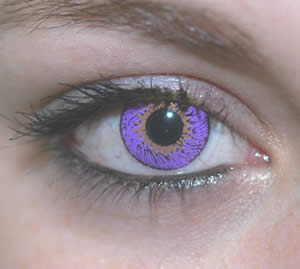
"The Girl With the Purple Eyes", recorded in Copenhagen in March 1975 by Dexter Gordon with the Palle Mikkelborg Tentet, comes from the end of Gordon's European exile. The fantastically-named Niels-Henning Orsted Pedersen provides the groove on bass. Find on More Than You Know.
Purple hair is another sign of distinction--it was a popular wig tint during the Napoleonic era. Colette had "mauve-tinted hair", as did Warhol superstar Ultra Violet, while the king of Megara, Nisus, had purple locks that were shorn by his daughter Scylla to win the love of Minos.
"Purple Toupee" is a funny bit of revenge on the Baby Boomers (as perhaps can only be appreciated by the generations that have lived in their wake), in which the addled Boomer narrator recalls the Very Important Events of the 1960s as a mythical pop-cultural slush, in which protesters chanted "Free the Expo 67!". On They Might Be Giants' 1988 Lincoln; find on Then: The Earlier Years.

Francis Bacon, Figure With Meat, 1954.
Yet purple sensuality, while appealing in person, can be murder in literature. Purple writing--gassy prose stuffed with elongated metaphors, classical references, alliteration and other crimes--has plagued us for centuries. (Hopefully not too much of it in this blog, but likely so.) Lawrence Durell admitted his "prose was touched with plum pudding." And in V for Vendetta, the lecherous clergyman Bishop Lilliman notes that the sermon he was told to read by the computer Fate was "a trifle purple." (The Bishop soon meets his well-deserved fate, and over his corpse the anarchist V places a violet carson, a breed of flower unknown in fascist Britain.)
"Ruskin's style -- a thing of shreds and purple patches," said Lawson. "Besides, damn the Great Victorians. Whenever I open a paper and see Death of a Great Victorian, I thank Heaven there's one more of them gone. Their only talent was longevity, and no artist should be allowed to live after he's forty; by then a man has done his best work, all he does after that is repetition."
W.S. Maugham, Of Human Bondage.
Final rites
As I lay awake at night-time
In an ancient country barrack known to ancient cannoneers,
And recalled the hopes that heralded each seeming brave and bright time
Of my primal purple years
Hardy, The Revisitation.
Today, black is the accepted color of mourning (except in some Asian countries, where white is appropriate), but purple, for much of human history, has also served this purpose. Because purple is the end of the spectrum, the color that bleeds off into ultraviolet and invisibility, it seems fitting and proper for it to denote the end of our little lives.

Purple as mourning color was especially prominent in England. Samuel Pepys, in 1660, wrote in his diary that he had gone to White Hall Garden, "where I saw the King in purple mourning for his brother." The Victorians were clad in Perkin's mauve in funeral processions throughout the late 19C, and in 1952, when George VI died, West End haberdashers placed black and mauve knickers in their windows.
Constance, in Arnold Bennett's The Old Wives Tale, watches a funeral procession pass, playing Handel's Funeral March: "The boom of the drum, desolating the grief; and the dirge seemed to be weaving a purple pall that covered every meanness." Or take the lines from Gregory Corso's Italian Extravaganza:
Mrs. Lombardi's month-old son is dead
I saw it in Rizzo's funeral parlor
A small purplish wrinkled head.
And Graham Greene, towards the end of his life, recalled a dream in which he wrote a verse on his own death, for a competition in a magazine called Time and Tide, a dream-poem that began:
My breath is folded up
like sheets in lavender
The end for me
Arrives like nursery tea...
An indigo quartet
Now the shadow has fallen and the purple light slants downwards. The figure that was robed in beauty is now clothed in ruin.
Woolf, The Waves.
So we've reached the end of the spectrum: the colors are draining away, summertime and light are hastening off, and darkness will soon be all that's left. So here is a last quartet to help enjoy the final embers.

"Mood Indigo" is one of Duke Ellington's most sublime pieces, a melody which, the first time you hear it (perhaps today, o lucky you), seems already familiar, as though you can half-remember it from a dream; it's a dance for somnambulists.
Who actually wrote it remains a bit of a controversy—-Ellington claimed he dashed it out one evening, in fifteen minutes, waiting for his mother to finish cooking dinner, then handed it to Irving Mills, who wrote the lyrics. Yet Barney Bigard, Ellington’s clarinet player, claimed he wrote the lion’s share of it, with Ellington only providing the beginning, adding that Mills basically gave him $25 to pay him off. (By the 1960s, Bigard’s name was included in the list of composers.) And further, Mitchell Parish has claimed that he wrote most of Mills’ lyrics.
The inaugural version of “Mood Indigo," recorded in October 1930, features the haunting theme statement provided by Bigard, Arthur Whetsol (t) and Joe Nanton (tb), followed by Bigard’s ethereal solo and a pair of dazzlers from Whetsol and Ellington. On Masterpieces.
Sinatra placed it prominently in his 1955 masterpiece In the Wee Small Hours. And a decade later, Nina Simone turns it into a soulful jaunt, with her piano leading the charge. On Nina.

In 1950, Ellington had begun exploiting the new long-playing 33rpm discs, opening up compositions that he had originally structured as tightly-coiled three-minute dramas. Now there was room to breathe, for his players to roll out. So in this version, "Mood Indigo" dreams along for a quarter of an hour. It begins with a brief curtain-raiser by Duke (or maybe Billy Strayhorn) on piano, and then the winds, purpureal and solemn, lead you onward. Seemingly the entire orchestra gets a solo—-some of the most notable are Tyree Glenn, who provides the “wah-wah” trumpet, Russell Procope (clarinet), Johnny Hodges (alto sax), Paul Gonsalves (tenor sax), Ray Nance (trumpet). And the vocal is by Ellington's then-recent addition Yvonne Lanauze.
Ted Gioia: "This was the closest Ellington ever came to creating an African-American equivalent of Bach's Goldberg Variations." One of the best recordings Duke ever made, it's found on the justly-named Masterpieces by Ellington. Unfortunately, due to its length, the track had to get compressed terribly to get on the server--the sound is likely pretty poor. Please check out the CD if you like it.
Cover star: the Hon. Condoleeza Rice.
Next and last, a (BRIEF!) coda:
If she be black, and thereto have a wit,
She'll find a white that shall her blackness fit.

